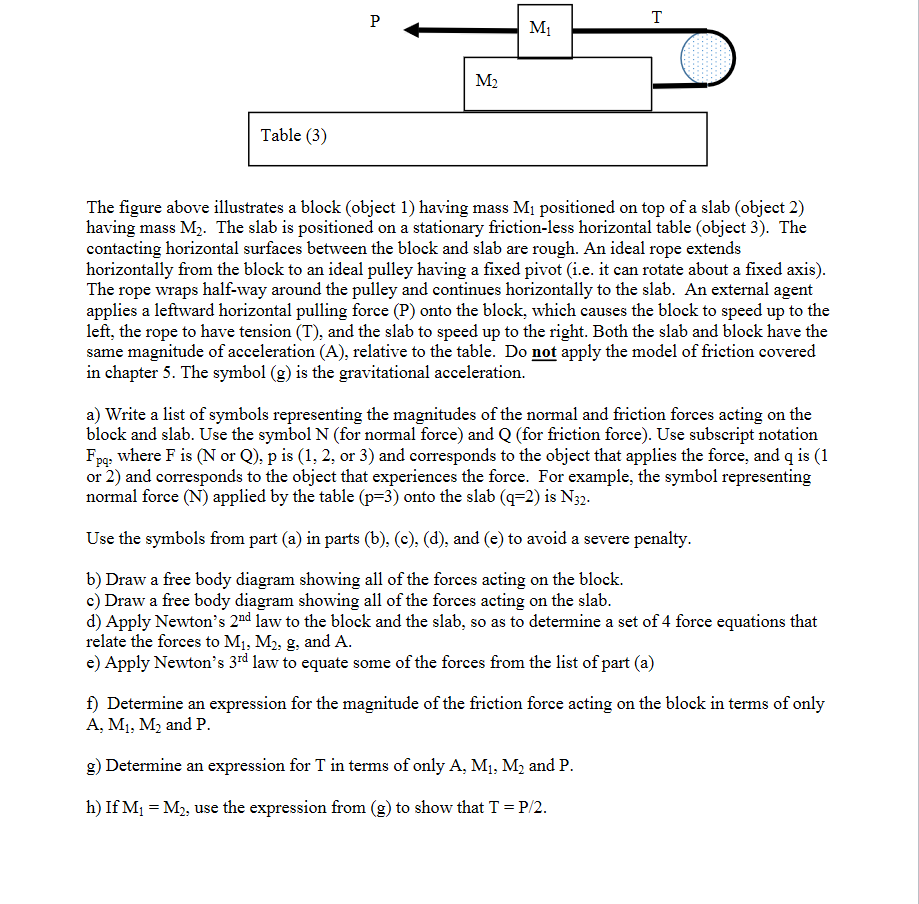a) Write a list of symbols representing the magnitudes of the normal and friction forces acting on the block and slab. Use the symbol N (for normal force) and Q (for friction force). Use subscript notation Fpg, where F is (N or Q), p is (1, 2, or 3) and corresponds to the object that applies the force, and q is (1 or 2) and corresponds to the object that experiences the force. For example, the symbol representing normal force (N) applied by the table (p=3) onto the slab (q=2) is N32. Use the symbols from part (a) in parts (b), (c), (d), and (e) to avoid a severe penalty. b) Draw a free body diagram showing all of the forces acting on the block. c) Draw a free body diagram showing all of the forces acting on the slab.
a) Write a list of symbols representing the magnitudes of the normal and friction forces acting on the block and slab. Use the symbol N (for normal force) and Q (for friction force). Use subscript notation Fpg, where F is (N or Q), p is (1, 2, or 3) and corresponds to the object that applies the force, and q is (1 or 2) and corresponds to the object that experiences the force. For example, the symbol representing normal force (N) applied by the table (p=3) onto the slab (q=2) is N32. Use the symbols from part (a) in parts (b), (c), (d), and (e) to avoid a severe penalty. b) Draw a free body diagram showing all of the forces acting on the block. c) Draw a free body diagram showing all of the forces acting on the slab.
Physics for Scientists and Engineers, Technology Update (No access codes included)
9th Edition
ISBN:9781305116399
Author:Raymond A. Serway, John W. Jewett
Publisher:Raymond A. Serway, John W. Jewett
Chapter10: Rotation Of A Rigid Object About A Fixed Axis
Section: Chapter Questions
Problem 10.15CQ: Figure CQ10.15 shows a side view of a childs tricycle with rubber tires on a horizontal concrete...
Related questions
Topic Video
Question
100%

Transcribed Image Text:P
T
M1
M2
Table (3)
The figure above illustrates a block (object 1) having mass Mi positioned on top of a slab (object 2)
having mass M2. The slab is positioned on a stationary friction-less horizontal table (object 3). The
contacting horizontal surfaces between the block and slab are rough. An ideal rope extends
horizontally from the block to an ideal pulley having a fixed pivot (i.e. it can rotate about a fixed axis).
The rope wraps half-way around the pulley and continues horizontally to the slab. An external agent
applies a leftward horizontal pulling force (P) onto the block, which causes the block to speed up to the
left, the rope to have tension (T), and the slab to speed up to the right. Both the slab and block have the
same magnitude of acceleration (A), relative to the table. Do not apply the model of friction covered
in chapter 5. The symbol (g) is the gravitational acceleration.
a) Write a list of symbols representing the magnitudes of the normal and friction forces acting on the
block and slab. Use the symbol N (for normal force) and Q (for friction force). Use subscript notation
Fpg: where F is (N or Q), p is (1, 2, or 3) and corresponds to the object that applies the force, and q is (1
or 2) and corresponds to the object that experiences the force. For example, the symbol representing
normal force (N) applied by the table (p=3) onto the slab (q=2) is N32.
Use the symbols from part (a) in parts (b), (c), (d), and (e) to avoid a severe penalty.
b) Draw a free body diagram showing all of the forces acting on the block.
c) Draw a free body diagram showing all of the forces acting on the slab.
d) Apply Newton's 2nd law to the block and the slab, so as to determine a set of 4 force equations that
relate the forces to M1, M2, g, and A.
e) Apply Newton's 3rd law to equate some of the forces from the list of part (a)
f) Determine an expression for the magnitude of the friction force acting on the block in terms of only
A, M1, M2 and P.
g) Determine an expression for T in terms of only A, M1, M2 and P.
h) If M1 = M2, use the expression from (g) to show that T = P/2.
Expert Solution
This question has been solved!
Explore an expertly crafted, step-by-step solution for a thorough understanding of key concepts.
This is a popular solution!
Trending now
This is a popular solution!
Step by step
Solved in 2 steps with 4 images

Knowledge Booster
Learn more about
Need a deep-dive on the concept behind this application? Look no further. Learn more about this topic, physics and related others by exploring similar questions and additional content below.Recommended textbooks for you

Physics for Scientists and Engineers, Technology …
Physics
ISBN:
9781305116399
Author:
Raymond A. Serway, John W. Jewett
Publisher:
Cengage Learning

Physics for Scientists and Engineers
Physics
ISBN:
9781337553278
Author:
Raymond A. Serway, John W. Jewett
Publisher:
Cengage Learning

Physics for Scientists and Engineers with Modern …
Physics
ISBN:
9781337553292
Author:
Raymond A. Serway, John W. Jewett
Publisher:
Cengage Learning

Physics for Scientists and Engineers, Technology …
Physics
ISBN:
9781305116399
Author:
Raymond A. Serway, John W. Jewett
Publisher:
Cengage Learning

Physics for Scientists and Engineers
Physics
ISBN:
9781337553278
Author:
Raymond A. Serway, John W. Jewett
Publisher:
Cengage Learning

Physics for Scientists and Engineers with Modern …
Physics
ISBN:
9781337553292
Author:
Raymond A. Serway, John W. Jewett
Publisher:
Cengage Learning

College Physics
Physics
ISBN:
9781938168000
Author:
Paul Peter Urone, Roger Hinrichs
Publisher:
OpenStax College

Principles of Physics: A Calculus-Based Text
Physics
ISBN:
9781133104261
Author:
Raymond A. Serway, John W. Jewett
Publisher:
Cengage Learning